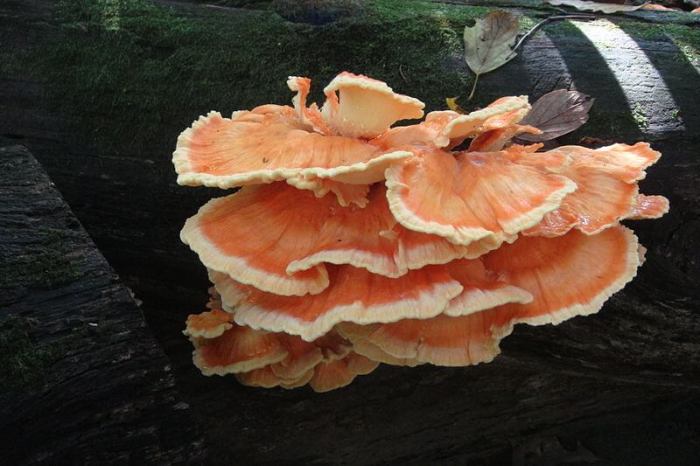
Chicken of the woods recipe – Dive into the realm of chicken of the woods, a wild mushroom that tantalizes taste buds and ignites culinary adventures. With its earthy, slightly sweet, and meaty notes, this versatile ingredient transforms dishes into unforgettable experiences. Embark on a gastronomic journey as we explore the wonders of chicken of the woods, from its nutritional value to delectable cooking techniques.
As you venture into the world of chicken of the woods, you’ll discover a plethora of recipe variations, each offering unique flavors and textures. Learn how to sauté, roast, and grill this wild mushroom, enhancing its taste with herbs, marinades, and complementary ingredients.
Discover the art of foraging responsibly and identifying chicken of the woods safely, ensuring an ethical and sustainable culinary experience.
Recipe Variations

Chicken of the woods is a versatile mushroom that can be cooked in various ways to create unique and flavorful dishes. Each variation offers its own distinct characteristics and advantages, making it suitable for different occasions and preferences.
Cooking Methods
The most common cooking methods for chicken of the woods include:
- Pan-frying:This method yields crispy, browned mushrooms that are perfect for tacos, sandwiches, or salads.
- Roasting:Roasting brings out the earthy flavors of the mushrooms and makes them tender and juicy. Roasted chicken of the woods can be served as a main course or side dish.
- Grilling:Grilling gives chicken of the woods a smoky flavor and a slightly charred exterior. Grilled mushrooms can be used in kebabs, sandwiches, or as a topping for pizza.
- Sautéing:Sautéing is a quick and easy way to cook chicken of the woods. Sautéed mushrooms are perfect for stir-fries, soups, or omelets.
Flavor Profiles
In addition to cooking methods, the flavor profile of chicken of the woods can be enhanced through the use of various ingredients and seasonings. Some popular flavor variations include:
- Garlic and herb:This classic combination brings out the natural flavors of the mushrooms and adds a touch of savory complexity.
- Lemon and thyme:The bright acidity of lemon and the earthy aroma of thyme complement the mushrooms’ earthy flavors.
- Soy sauce and ginger:This Asian-inspired variation adds a salty and umami flavor to the mushrooms.
- Spicy:Adding chili peppers or cayenne pepper to the cooking process gives the mushrooms a kick of heat.
Suitability
The suitability of each variation depends on the occasion and preferences. For example, pan-fried chicken of the woods is a quick and easy option for a weeknight meal, while roasted chicken of the woods is a more elegant choice for a special occasion.
The flavor profile can also be tailored to match the preferences of the diners. For those who prefer a classic flavor, garlic and herb is a good choice, while those who enjoy bolder flavors may prefer soy sauce and ginger or spicy variations.
Nutritional Value and Health Benefits

Chicken of the woods is not only a culinary delight but also a nutritional powerhouse. It boasts an impressive array of vitamins, minerals, and antioxidants that contribute to overall well-being.
This fungus is particularly rich in vitamins B and D. Vitamin B complex supports energy production, metabolism, and nervous system function. Vitamin D plays a crucial role in bone health and immune system function.
Antioxidant Content, Chicken of the woods recipe
Chicken of the woods is a rich source of antioxidants, including ergothioneine and phenolics. Antioxidants help protect cells from damage caused by free radicals, which can contribute to chronic diseases such as cancer and heart disease.
Health Benefits
Consuming chicken of the woods has been associated with several potential health benefits, including:
- Immune system support:The high levels of vitamins and antioxidants in chicken of the woods may help boost the immune system and protect against infections.
- Anti-inflammatory properties:Chicken of the woods contains compounds that have anti-inflammatory effects, which may benefit conditions such as arthritis and inflammatory bowel disease.
Recommended Serving Size and Frequency
To reap the health benefits of chicken of the woods, it is recommended to consume a serving of 1-2 cups cooked mushrooms once or twice a week. This serving size provides a significant amount of nutrients without excessive intake.
Foraging and Identification

Chicken of the woods is a widely distributed fungus that grows in forests worldwide. Its unique appearance and distinct flavor have made it a popular choice among foragers and mushroom enthusiasts.
Habitat and Growing Season
Chicken of the woods typically grows at the base of oak trees or on dead oak logs. It prefers moist, shaded areas and is most commonly found during the fall months, from late summer to early winter.
Identification
Identifying chicken of the woods is crucial to avoid confusion with similar-looking species. Its distinguishing characteristics include:
- Color:Bright orange to yellow, with a slightly faded appearance at the edges.
- Shape:Irregular, shelf-like clusters with wavy or lobed margins.
- Texture:Soft and velvety, with a slightly spongy interior.
li> Spores:White to cream-colored, produced on the underside of the mushroom.
Look-alikes:Chicken of the woods has a few look-alikes, including false chicken of the woods ( Laetiporus sulphureus) and Gomphus clavatus. However, these species have different colors, textures, and growing habits.
Responsible Foraging
Foraging for chicken of the woods requires responsible practices to ensure its sustainability. It is essential to:
- Harvest sustainably:Only take what you need and leave the rest for other foragers and wildlife.
- Identify correctly:Avoid harvesting mushrooms that you are unsure of, as misidentification can lead to health risks.
- Respect the environment:Do not damage trees or disturb the surrounding ecosystem while foraging.
Cooking Techniques and Flavor Profile
Chicken of the woods, with its versatile texture, lends itself to a range of cooking methods, each highlighting its unique characteristics.
When sautéed, chicken of the woods develops a tender, almost chicken-like texture, with a slightly crispy exterior. Roasting intensifies its earthy flavors, resulting in a juicy and flavorful dish. Grilling imparts a smoky, charred flavor, adding an extra layer of complexity.
Flavor Profile
Chicken of the woods possesses a distinctive flavor profile that sets it apart from other mushrooms. Its earthy, slightly sweet notes evoke the flavors of the forest, while its meaty texture adds a satisfying chew.
To enhance its natural flavors, season chicken of the woods generously with salt, pepper, and herbs such as thyme or rosemary. Marinating it in a flavorful liquid, such as a mixture of olive oil, soy sauce, and garlic, can further deepen its taste.
When pairing chicken of the woods with other ingredients, consider its earthy notes. It complements rich flavors such as roasted vegetables, creamy sauces, and hearty grains. Its meaty texture also makes it a suitable substitute for chicken in dishes like stir-fries, soups, and stews.
Culinary Applications and Pairing Suggestions
Chicken of the woods is a versatile culinary ingredient with a wide range of applications. Its unique flavor and texture make it a great addition to soups, stews, and salads, where it can be used as a meat substitute or as a complementary ingredient.
Pairing Suggestions
Chicken of the woods pairs well with a variety of vegetables, including leafy greens, root vegetables, and mushrooms. It also complements herbs such as thyme, rosemary, and sage, and sauces like cream sauces, gravies, and vinaigrettes.
Creative Incorporations
- Soups and Stews:Add diced chicken of the woods to hearty soups and stews for a meaty texture and earthy flavor.
- Salads:Tear or slice chicken of the woods and toss it into salads for a protein-packed and flavorful addition.
- Meat Substitute:Use chicken of the woods as a plant-based meat substitute in tacos, burgers, and stir-fries.
- Fried Bites:Dredge chicken of the woods in batter and fry it for crispy and flavorful bites.
- Pasta Dishes:Sauté chicken of the woods with vegetables and add it to pasta dishes for a hearty and savory meal.
Epilogue

As we bid farewell to our culinary adventure with chicken of the woods, remember that this wild mushroom is more than just a delicacy. Its nutritional value and health benefits make it a wise choice for a balanced diet. Embrace the versatility of chicken of the woods, experimenting with it in soups, stews, salads, and even as a meat substitute.
Let your creativity soar as you explore the endless possibilities that this culinary gem offers.
General Inquiries: Chicken Of The Woods Recipe
What are the health benefits of chicken of the woods?
Chicken of the woods is rich in vitamins, minerals, and antioxidants, supporting immune system function and exhibiting anti-inflammatory properties.
How can I identify chicken of the woods safely?
Look for bright orange to yellow shelf-like structures with a velvety texture and avoid look-alikes with different colors or gills.
What are some creative ways to use chicken of the woods?
Experiment with chicken of the woods in tacos, stir-fries, pasta dishes, and even desserts like mushroom ice cream.






